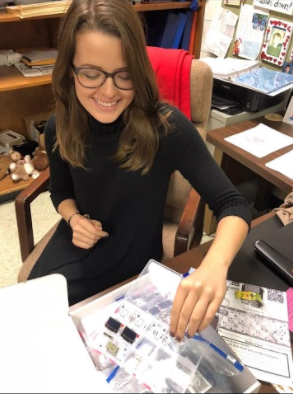
Caption: Logsdon designating tasks to members for the project.
photo courtesy Morgan Logsdon
Godwin students venture into space exploration with the College of William and Mary
Godwin will embark on its first space mission in the near future.
Thirteen Godwin students along with physics teacher Michael Fetsko have recently been selected to participate in the development of a satellite with the intention of launching it into space.
Dr. Joshua Erlich, a physics professor at the College of William and Mary, approached Fetsko last year about the possibility of designing an experiment to build a satellite with the end goal of launching the satellite into space for data collection.
Fetsko then brought the idea to senior Morgan Logsdon in the spring of last year, and asked if she would lead the project.
“Either Fetsko or I approached each member individually. We would talk about different people and bounce suggestions off each other to put together a team of highly curious, enthusiastic people,” said Logsdon.
Starting with four members at the end of last year, and growing to 14 members at the beginning of this year, the team has begun the first phase of the project– research.
Currently, the team has been doing research on Volatile Organic Compounds (VOCs) in the troposphere as well as infrared radiation. They will soon enter their next phase and begin to put together the first version of the satellite.
The team faced a small bump in the road earlier in the year when they learned the sensors required for their original plan and design were not available.
However, despite the setback, the project will soon be on its way and develop from an idea into reality.
The test phase will consist of two balloon launches, then, a research paper will be written, and the final phase will include the actual space launch.
The students have received a box of various sensors and connectors from Twiggs Space Lab, including Wi-Fi and GPS chips, as well as various weather-related sensors, and will use them to construct a thin satellite (ThinSat) that will go up in the balloon launches.
After proving they can successfully design and execute an experiment, the group will build their final satellite.
“The project allows high school students to get an exposure to something we might want to do in our futures by really challenging us to think in a different way,” said senior Kaylee Butterworth.
The final satellite will launch on the Antares rocket that launches every six months to take food and supplies to the International Space Station (ISS), and will be dropped into low-earth orbit, remaining there for a week until it burns up entirely in the atmosphere.
William and Mary, along with the Virginia Space Program, are sponsoring Godwin’s project. However, Godwin is not the only school participating in such an experiment.
William and Mary is currently sponsoring the Steward School, Bruton High School, Warhill High School in Williamsburg, and Hampton University.
There are currently 11 other groups of schools working on different satellites throughout the country, led by various institutions such as universities, the United States Coast Guard, and NASA.
“Leading this project has been so much fun- I love talking with the team to solve problems and figuring out what our next step is. This project has been a really great experience for both my education and my personal experience,” said Logsdon.


Be the first to comment on "One small step for man, one giant leap for Godwin"